《电路原理》双语教学大纲(英文版)
- 格式:doc
- 大小:32.50 KB
- 文档页数:4

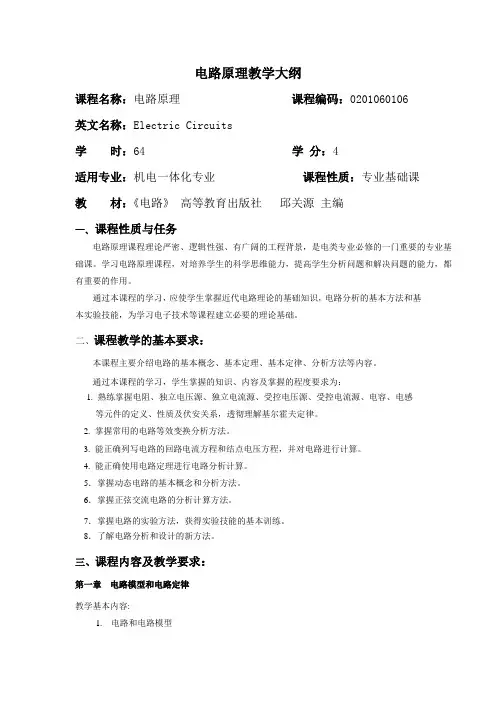
电路原理教学大纲课程名称:电路原理课程编码:020*******英文名称:Electric Circuits学时:64 学分:4适用专业:机电一体化专业课程性质:专业基础课教材:《电路》高等教育出版社邱关源主编一、课程性质与任务电路原理课程理论严密、逻辑性强、有广阔的工程背景,是电类专业必修的一门重要的专业基础课。
学习电路原理课程,对培养学生的科学思维能力,提高学生分析问题和解决问题的能力,都有重要的作用。
通过本课程的学习,应使学生掌握近代电路理论的基础知识,电路分析的基本方法和基本实验技能,为学习电子技术等课程建立必要的理论基础。
二、课程教学的基本要求:本课程主要介绍电路的基本概念、基本定理、基本定律、分析方法等内容。
通过本课程的学习,学生掌握的知识、内容及掌握的程度要求为:1. 熟练掌握电阻、独立电压源、独立电流源、受控电压源、受控电流源、电容、电感等元件的定义、性质及伏安关系,透彻理解基尔霍夫定律。
2. 掌握常用的电路等效变换分析方法。
3. 能正确列写电路的回路电流方程和结点电压方程,并对电路进行计算。
4. 能正确使用电路定理进行电路分析计算。
5.掌握动态电路的基本概念和分析方法。
6.掌握正弦交流电路的分析计算方法。
7.掌握电路的实验方法,获得实验技能的基本训练。
8.了解电路分析和设计的新方法。
三、课程内容及教学要求:第一章电路模型和电路定律教学基本内容:1. 电路和电路模型2. 电流和电压的参考方向3. 电功率和能量4. 电路元件5. 电阻元件6. 电压源和电流源7. 受控电源8. 基尔霍夫定律重点:1. 电流、电压参考方向;2. 元件、电路吸收或发出功率的表达式和计算;3. 电阻、独立电源和受控源等电路元件的伏安特性;4. 基尔霍夫定律。
难点:1. 功率计算;2. 独立电源和受控源等电路元件的伏安特性;3. 基尔霍夫电压定律。
本章主要教学要求:了解电路模型、电路元件的概念,理解电流、电压参考方向的概念,掌握元件、电路吸收或发出功率的表达式和计算;熟练掌握电阻、独立电源和受控源等电路元件的伏安特性;理解基尔霍夫定律的内容并能熟练应用该定律进行电路的分析计算。
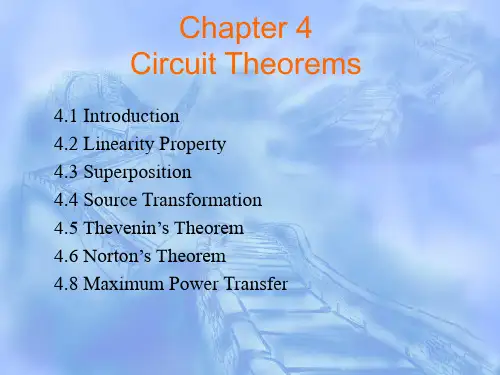
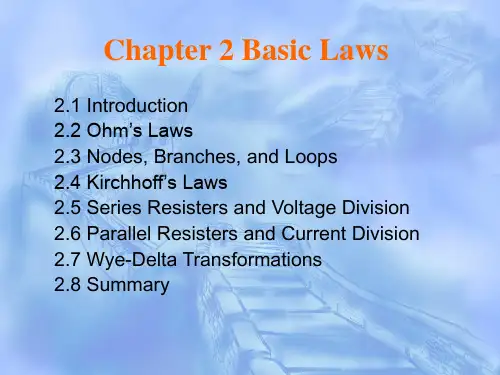
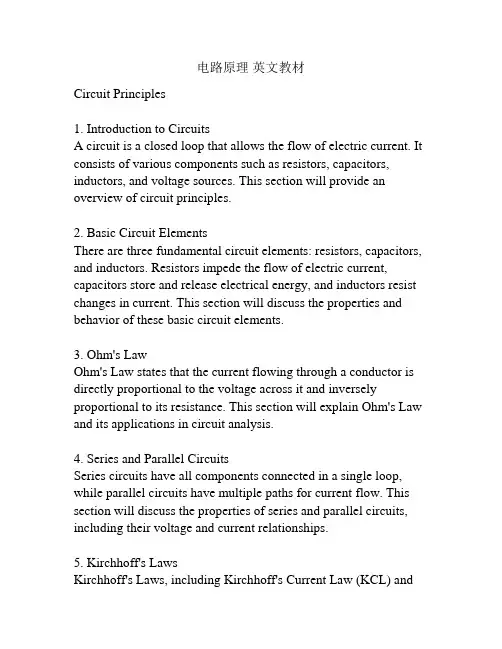
电路原理英文教材Circuit Principles1. Introduction to CircuitsA circuit is a closed loop that allows the flow of electric current. It consists of various components such as resistors, capacitors, inductors, and voltage sources. This section will provide an overview of circuit principles.2. Basic Circuit ElementsThere are three fundamental circuit elements: resistors, capacitors, and inductors. Resistors impede the flow of electric current, capacitors store and release electrical energy, and inductors resist changes in current. This section will discuss the properties and behavior of these basic circuit elements.3. Ohm's LawOhm's Law states that the current flowing through a conductor is directly proportional to the voltage across it and inversely proportional to its resistance. This section will explain Ohm's Law and its applications in circuit analysis.4. Series and Parallel CircuitsSeries circuits have all components connected in a single loop, while parallel circuits have multiple paths for current flow. This section will discuss the properties of series and parallel circuits, including their voltage and current relationships.5. Kirchhoff's LawsKirchhoff's Laws, including Kirchhoff's Current Law (KCL) andKirchhoff's Voltage Law (KVL), are essential for analyzing complex circuits. KCL states that the sum of currents entering a node is equal to the sum of currents leaving it, while KVL states that the sum of voltages in any closed loop is zero. This sectionwill explain how to apply Kirchhoff's Laws in circuit analysis.6. Circuit Analysis TechniquesThere are various methods for circuit analysis, such as nodal analysis, mesh analysis, and Thevenin's and Norton's theorems. This section will introduce these techniques and provide examples of their applications.7. Frequency AnalysisCircuits can behave differently at different frequencies. Frequency analysis helps understand how circuits respond to different input signals. This section will cover concepts like impedance, reactance, and frequency response.8. Transient AnalysisTransient analysis examines circuit behavior during the transition from one steady-state condition to another. It involves studying capacitive and inductive effects on the circuit's response. This section will explain how to analyze transient circuits.9. AmplifiersAmplifiers are essential components in electronic systems that increase the amplitude of signals. This section will provide an overview of amplifier circuits, including common amplifier configurations and their applications.10. FiltersFilters are circuits that selectively allow or block certain frequencies. They are used in various applications, such as signal processing and communication systems. This section will discuss different types of filters, including low-pass, high-pass, band-pass, and band-stop filters.11. OscillatorsOscillators generate periodic waveforms without an input signal. They are widely used in applications such as electronic clocks, radio transmitters, and audio signal generators. This section will explain the working principles of oscillators and different oscillator circuits.12. Digital Logic CircuitsDigital logic circuits use binary signals to perform logical operations. They are the building blocks of digital systems such as computers and calculators. This section will introduce basic digital logic gates and their applications.13. Power ElectronicsPower electronics deals with the control and conversion of electrical power. It has applications in areas such as power supplies, motor drives, and renewable energy systems. This section will cover power electronic devices and their operating principles.14. Troubleshooting and SafetyThis section will provide tips for troubleshooting circuit problems and ensuring safety while working with circuits. It will covercommon issues, testing procedures, and safety precautions to follow when dealing with electric circuits.。
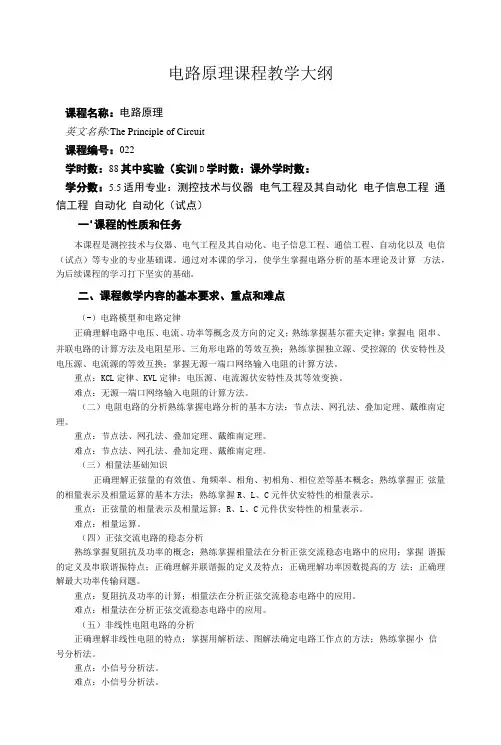
电路原理课程教学大纲课程名称:电路原理英文名称:The Principle of Circuit课程编号:022学时数:88其中实验(实训D学时数:课外学时数:学分数:5.5适用专业:测控技术与仪器电气工程及其自动化电子信息工程通信工程自动化自动化(试点)一'课程的性质和任务本课程是测控技术与仪器、电气工程及其自动化、电子信息工程、通信工程、自动化以及电信(试点)等专业的专业基础课。
通过对本课的学习,使学生掌握电路分析的基本理论及计算方法,为后续课程的学习打下坚实的基础。
二、课程教学内容的基本要求、重点和难点(-)电路模型和电路定律正确理解电路中电压、电流、功率等概念及方向的定义;熟练掌握基尔霍夫定律;掌握电阻串、并联电路的计算方法及电阻星形、三角形电路的等效互换;熟练掌握独立源、受控源的伏安特性及电压源、电流源的等效互换;掌握无源一端口网络输入电阻的计算方法。
重点:KCL定律、KVL定律;电压源、电流源伏安特性及其等效变换。
难点:无源一端口网络输入电阻的计算方法。
(二)电阻电路的分析熟练掌握电路分析的基本方法:节点法、网孔法、叠加定理、戴维南定理。
重点:节点法、网孔法、叠加定理、戴维南定理。
难点:节点法、网孔法、叠加定理、戴维南定理。
(三)相量法基础知识正确理解正弦量的有效值、角频率、相角、初相角、相位差等基本概念;熟练掌握正弦量的相量表示及相量运算的基本方法;熟练掌握R、L、C元件伏安特性的相量表示。
重点:正弦量的相量表示及相量运算;R、L、C元件伏安特性的相量表示。
难点:相量运算。
(四)正弦交流电路的稳态分析熟练掌握复阻抗及功率的概念;熟练掌握相量法在分析正弦交流稳态电路中的应用;掌握谐振的定义及串联谐振特点;正确理解并联谐振的定义及特点;正确理解功率因数提高的方法;正确理解最大功率传输问题。
重点:复阻抗及功率的计算;相量法在分析正弦交流稳态电路中的应用。
难点:相量法在分析正弦交流稳态电路中的应用。
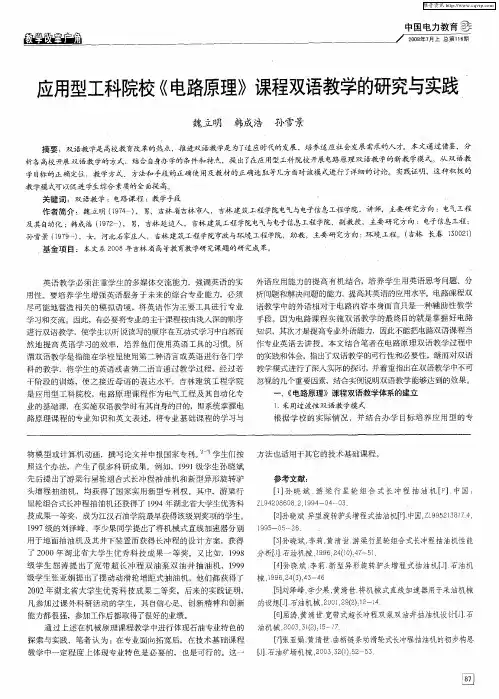
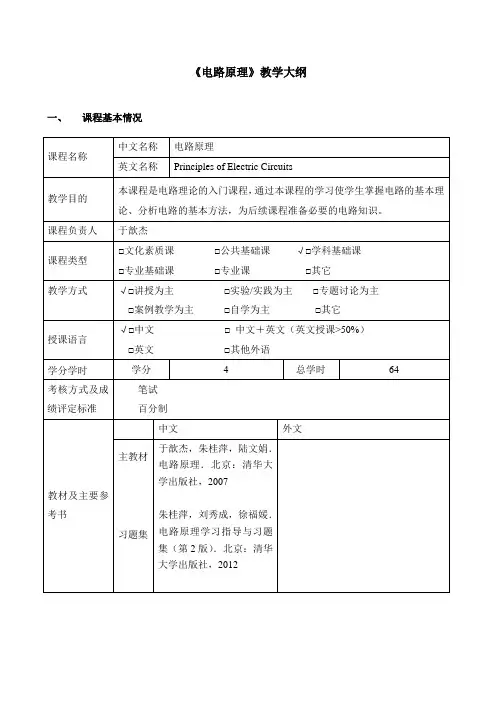
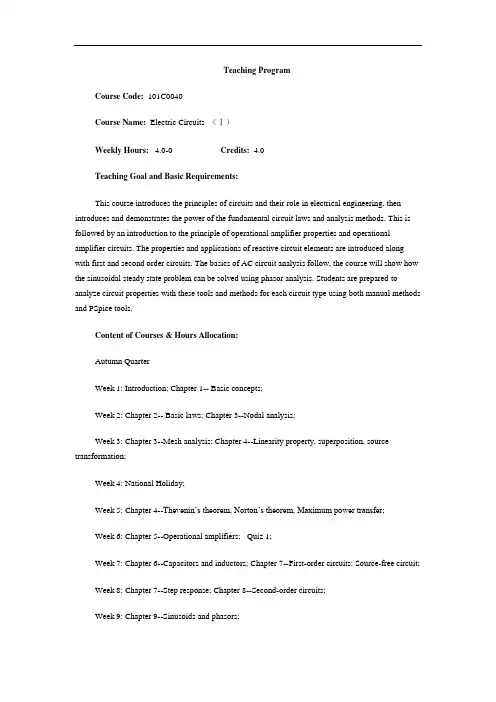
Teaching ProgramCourse Code: 101C0040Course Name: Electric Circuits (Ⅰ)Weekly Hours: 4.0-0 Credits: 4.0Teaching Goal and Basic Requirements:This course introduces the principles of circuits and their role in electrical engineering, then introduces and demonstrates the power of the fundamental circuit laws and analysis methods. This is followed by an introduction to the principle of operational amplifier properties and operational amplifier circuits. The properties and applications of reactive circuit elements are introduced along with first and second order circuits. The basics of AC circuit analysis follow, the course will show how the sinusoidal steady state problem can be solved using phasor analysis. Students are prepared to analyze circuit properties with these tools and methods for each circuit type using both manual methods and PSpice tools.Content of Courses & Hours Allocation:Autumn QuarterWeek 1: Introduction; Chapter 1-- Basic concepts;Week 2: Chapter 2-- Basic laws; Chapter 3--Nodal analysis;Week 3: Chapter 3--Mesh analysis; Chapter 4--Linearity property, superposition, source transformation;Week 4: National Holiday;Week 5: Chapter 4--Thevenin’s theorem, Norton’s theorem, Maximum power transfer;Week 6: Chapter 5--Operational amplifiers; Quiz 1;Week 7: Chapter 6--Capacitors and inductors; Chapter 7--First-order circuits: Source-free circuit;Week 8: Chapter 7--Step response; Chapter 8--Second-order circuits;Week 9: Chapter 9--Sinusoids and phasors;Winter QuarterWeek 1: Chapter 10--Sinusoidal steady-state analysis; Quiz 2;Week 2: Circuit analysis with Pspice; Lab exercise--Circuit analysis with Pspice;Week 3: Chapter 11--AC power analysis: Effective or RMS value, Power factor;Week 4: Chapter 12--Three-phase circuits; Power in a system;Week 5: Chapter 13--Magnetically coupled circuits: Mutual inductance; Linear transformers, Ideal autotransformers;Week 6: Chapter 14--Frequency response: Transfer function, Resonance; Quiz 3;Week 7: New Year Holiday; Chapter 14--Passive filters; Circuit applications;Week 8: Chapter 16--The Fourier series: Average and RMS value; Review;Week 9: Review;Teaching Plan:The course grade is calculated based on:Homework 10%, Quiz 30% (two top scores from 3 quiz, 15% each), PSpice Assignment 5%, Final Exam: 55%Homework will be given full credit if the work is completed and the solutions understandable.Recommended Textbooks and Other References: (books, editors, publishing company,publishing time)1.Fundamentals of Electric Circuits,Charles K. Alexander, Matthew N.O. Sadiku,McGraw-Hill Companies Inc,2000.122.PSpice and MATLAB for Electric Circuit Analysis,Tong Mei,Machine Industry Press,2005.73.Principles of Electric Circuits,Fan Chengzhi,Sun Dun,Tong Mei,Machine Industry Press,2005.74.Electric Circuits (Four Edition),Qiu Guanyuan,High Education Press,1999.65.Electric Circuits (Six Edition),James W. Nilsson, Susan A. Riedel, Publishing House of Electronics Industry,2002.6Teaching ProgramCourse Code: 101C0050Course Name: Electric Circuits (II)Weekly Hours: 4.0-0 Credits: 2.0Teaching Goal and Basic Requirements:Transient response analysis, network functions, poles and zeros; solution of network equations using Laplace transforms, inverse transforms, convolution integral, two-port networks. Matrix formulation of circuit equations, nodal Analysis and mesh analysis. Introduction of distributed circuits, distributed circuits of finite length, traveling wave, lossless transmission line of finite length. Analysis of nonlinear circuits, linearized circuit models, small signal analysis. Circuit analysis with MATLAB.Content of Courses & Hours Allocation:Spring QuarterWeek 1: Chapter 15--Definition of Laplace transform; Properties of the Laplace transform; The inverse Laplace transform; Application to circuits; Transfer function;Week 2: The convolution integral; Network function and step response;Week 3: State variables and state equations; Circuit analysis with MATLAB;Week 4: Chapter 18--Two-port networks; Supplement 1: Matrix equations for network--Nodal Analysis;Week 5: Supplement 1: Matrix equations for network--Mesh Analysis;Week 6: Supplement 2: Distributed Circuits--Introduction, distributed circuits of finite length;Week 7: Supplement 2: Traveling wave; Lossless transmission line of finite length; Circuit analysis with MATLAB; Midterm exam;Week 8: Supplement 3: Simple nonlinear circuits--Introduction, Nonlinear resistor circuits, Small signal analysis; Review;Week 9: Review;Teaching Plan:The course grade is calculated based on:Homework 10%, Quiz 5%, Midterm 15%, MATLAB Assignment 10%, Final Exam 60%Homework will be given full credit if the work is completed and the solutions understandable.Recommended Textbooks and Other References: (books, editors, publishing company,publishing time)1.Fundamentals of Electric Circuits,Charles K. Alexander, Matthew N.O. Sadiku,McGraw-Hill Companies Inc,2000.122.Principles of Electric Circuits,Fan Chengzhi, Sun Dun, Tong Mei,Machine Industry Press,2004.73.PSpice and MATLAB for Electric Circuit Analysis,Tong Mei,Machine Industry Press,2005.74.Electric Circuits (Four Edition),Qiu Guanyuan,High Education Press,1999.65.Electric Circuits (Six Edition),James W. Nilsson, Susan A. Riedel, Publishing House of Electronics Industry,2002.6。
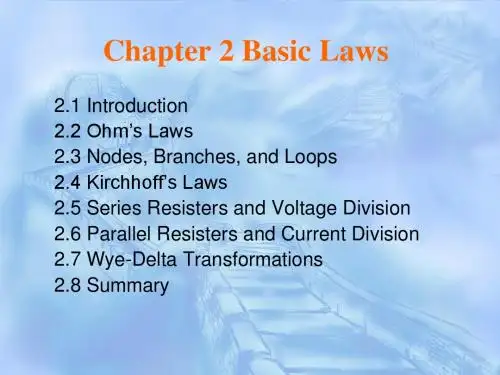
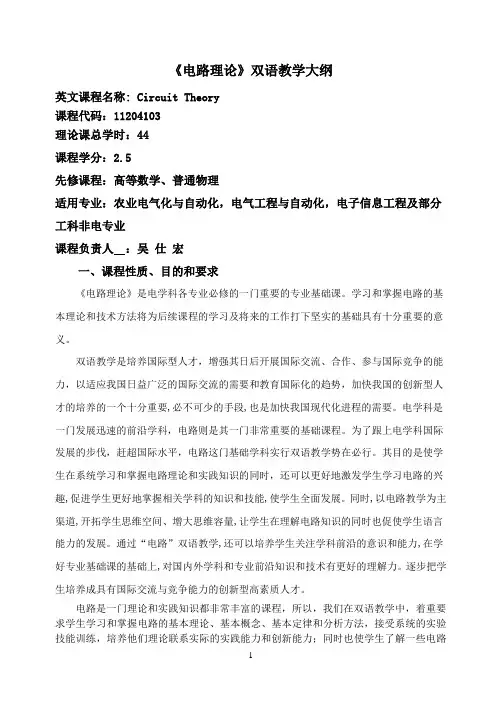
《电路理论》双语教学大纲英文课程名称: Circuit Theory课程代码:11204103理论课总学时:44课程学分:2.5先修课程:高等数学、普通物理适用专业:农业电气化与自动化,电气工程与自动化,电子信息工程及部分工科非电专业课程负责人:吴仕宏一、课程性质、目的和要求《电路理论》是电学科各专业必修的一门重要的专业基础课。
学习和掌握电路的基本理论和技术方法将为后续课程的学习及将来的工作打下坚实的基础具有十分重要的意义。
双语教学是培养国际型人才,增强其日后开展国际交流、合作、参与国际竞争的能力,以适应我国日益广泛的国际交流的需要和教育国际化的趋势,加快我国的创新型人才的培养的一个十分重要,必不可少的手段,也是加快我国现代化进程的需要。
电学科是一门发展迅速的前沿学科,电路则是其一门非常重要的基础课程。
为了跟上电学科国际发展的步伐,赶超国际水平,电路这门基础学科实行双语教学势在必行。
其目的是使学生在系统学习和掌握电路理论和实践知识的同时,还可以更好地激发学生学习电路的兴趣,促进学生更好地掌握相关学科的知识和技能,使学生全面发展。
同时,以电路教学为主渠道,开拓学生思维空间、增大思维容量,让学生在理解电路知识的同时也促使学生语言能力的发展。
通过“电路”双语教学,还可以培养学生关注学科前沿的意识和能力,在学好专业基础课的基础上,对国内外学科和专业前沿知识和技术有更好的理解力。
逐步把学生培养成具有国际交流与竞争能力的创新型高素质人才。
电路是一门理论和实践知识都非常丰富的课程,所以,我们在双语教学中,着重要求学生学习和掌握电路的基本理论、基本概念、基本定律和分析方法,接受系统的实验技能训练,培养他们理论联系实际的实践能力和创新能力;同时也使学生了解一些电路发展前沿的新理论、新动向和新技术,使学生打下电路基本理论和实际知识的坚实基础,较好地适应后续课程的双语教学及相关学科的学习。
二、教学内容、教学目标及学时分配绪论:《电路理论》的性质、目的和任务;电路理论的学习方法。
《电路原理》课程(双语)教学大纲(Theories of Circuit)学时:88学时学分:5.5(授课:88学时实验:另计)一、教育目标(性质与任务)电路原理是电气信息类专业的一门重要的技术基础课。
其任务是:通过本课程的学习,使学生掌握电路的基本理论、分析计算电路的基本方法和进行实验的初步技能,为解决工程实际问题和进一步研究电类问题准备必须的理论基础,并为学习电气信息类的后续课程打下基础。
电路课程理论严密,逻辑性强,对培养学生的辩证思维能力,树立理论联系实际的科学观点和提高学生分析问题解决问题的能力,都有重要的作用。
二、教学内容基本要求1.电路基础知识(l)掌握电路模型的概念。
(2) 掌握电路的基本物理量和电压、电流的参考方向。
(3)掌握电路元件的电压、电流关系。
(4)掌握电压源、电流源及受控源的特性。
(5)掌握电功率和电、磁能量的计算。
(6)掌握并应用基尔霍夫定律。
(7)理解端口的概念。
(8)理解线性元件和非线性元件的概念。
(9)理解图论的基本概念:图、树与树支,连支、割集、平面图。
2.电阻电路分析(1)掌握电路等效的概念和串、并联及混联电阻电路的计算。
了解星形连接与三角形连接的等效变换。
(2)掌握实际电源的两种电路模型及其等效互换。
(3)能用支路电流法列写电路方程。
(4)掌握回路分析法。
(5)掌握结点分析法。
(6)掌握叠加定理,理解替代定理和互易定理。
(7)掌握戴维南定理和诺顿定理及其应用。
(8)掌握最大功率传输的概念和应用。
(9)能分析简单的含受控源电路。
(10)掌握具有运算放大器的电阻电路的分析方法3.复变函数初步(1)掌握复数及其代数运算、复数的几何表示、复数的乘幂与方根。
(2)掌握区域的概念、复变函数的定义、映射的概念、复变函数的极限和连续性。
(3)掌握解析函数的概念、解析函数的充要条件。
(4)掌握指数函数、对数函数、幂函数、三角函数和双曲函数、反三角函数和反双曲函数。
4.正弦稳态电路分析(1)掌握正弦量的相量表示法。
Preface•Place of Electrical Circuits in Modern Technology IntroductionThe design of the circuits has 2 main objectives:1)To gather,store,process,transport,and present information.2)To distribute and convert energy between various forms.The study of circuits provides a foundation for areas of electrical engineering such as:•Communication system •Computer system •Control system •Electronics •Electromagnetic •Power systems •Signal processing•Motivation for doing this course •About the courseCircuit TheoryCircuit AnalysisCircuit Synthesis Circuits(given)Excitation (given)Response(unknown)Circuit AnalysisWhat we emphasize on,Since it provides the foundation forunderstanding the interaction of signalsolution.Circuits(unknown)Excitation (given)Response(given)Circuit synthesis(design)In contrast to analysis,a design problem may have nosolution or several solutions,Resistance circuits analysisDynamic circuits analysisSinusoidal steady stateThe course includes3parts:•Reference Books1)Fundamentals of Electric Circuits Charles K Alexander,Matthew N O Sadiku清华大学出版社2)The Analysis and Design of Linear Circuits Roland E.Thomas,Albert J.Rosa—2nd ed3)Electrical Engineering Principles and Applications Allan R.Hambley---2nd ed4)电路分析基础李瀚荪第三版5)电路邱关源第四版6)Electric Circuits Joseph Edminister,Mahmood Nahvi-----3rd edChapter 1 Fundamental KnowledgeCircuit and circuit model•Actual electrical component:a battery or a lightbulbActual electrical componentIdeal circuitcomponentEmphasize the main characterNeglect the left character•Ideal circuit component: amathematical model of an actualelectric component.R1VsRsCircuit model:A commonly used mathematical model for electric system.Lumped elements Lumped circuiti2-V+i1i1=i2V is certain Actual scale of the circuit is much smaller than the wavelength relating to the running frequency of the circuit.Circuit Type:•Linear----Nonlinear•Time invariant----Time variant •Passive----Active•Lumped----DistributiveCircuit Variablesdtdq i n Electric current is the time rate of change of charge, measured in amperes (A).A direct current (DC)is a current thatremains constant with time. (I)An alternating current (AC)is a current that varies sinusoidally with time.SortReference directioni >0 means the real direction isisame to the reference directioni <0 means the real direction isopposite to the reference directionCircuit VariablesVoltage (or potential difference) is the energy required to move a unit charge through an element, measured in volts(V). dqdw v Reference direction or voltage polarity -V +V>0 means the real polarity is sameto the reference polarity V<0 means the real polarity isopposite to the reference polaritypassive sign convention -V +iPassive sign convention is satisfied when current enters through the positive polarity of the voltage.Unless otherwise stated, we will follow thepassive sign convention throughout this course.Circuit VariablesPower is the time rate of expending or absorbing energy. Measured in watts(W)dtdw p =vi dtdq v dt dw p vdq dw ===∴= P=VI in a DC circuitusing passive signconvention Power absorbed = -Power suppliedReference polarities for power using passive sign conventionP > 0 absorbing powerP < 0 releasing or supplyingpowerExamplesLaw of conservation of energy must be obeyed in any electric circuit.∑=0p Power absorbed = -Power suppliedEnergy is the capacity to do work, measured in joules(J) ⎰⎰==t t tt vidt pdt w 00The energy absorbed or supplied by an element from time t0 to time t isCircuit ElementsPassive elements:resistors,capacitors,and inductorsActive elements:source,operational amplifiersVoltage and Current SourcesThe most important active elements are voltage or current sources that generally deliver power to the circuit connected to them. There are two kinds of sources: independent and dependent sources.An ideal independent source is an active element that provides a specified voltage or current that is completely independent of other circuit variables.Symbols for independent voltage source Symbols for independent voltage sourceNote:▪ 2 or more voltage sources with different value are not permissible to be connected in parallel▪ 2 or more current sources with different value are not permissible to be connected in series▪V oltage sources connected in series is equivalent to one voltage source▪Current sources connected in parallel is equivalent to one current source▪ A voltage source connected to any branch in parallel is equivalent to itself▪ A current source connected to any branch in series is equivalent to itselfAn ideal dependent(or controlled)source is an active element in which the source quantity is controlled by another voltage or current.Symbols for a) dependent voltage sources b) dependent current sources There are a total of fourvariations, namely:1.A voltage –controlled voltagesource (VCVS)2. A current –controlled voltagesource (CCVS)3. A voltage –controlled currentsource (VCCS)4. A current –controlled currentsource (CCCS)V1V1μVCVSV1V1g VCCS I1I1αCCCS I1V1γI1CCVSWhat is the difference between independent and dependent sources?ResistorsThe circuit element used to model the current –resisting behavior of a material is the resistor.Resistance is the capacity of materials to impede the flow of current.The resistance R of an element denotes its ability to resist the flowof electric current;it is measured in ohms(Ω)Symbol: R11ki u i ut1t2ui i u i ut1t2uiLinear Time InvariantLinear Time variant Nonlinear Time Invariant Nonlinear Time Variant Open Circuit Short CircuitLinear Resistor:The resistance of the idea resistor is constant and its value doesnot vary over time.The relation between voltage and current.(V AR)vV=Ri(passive sign convention)i-------Ohm’s LawSince the value of R can range from zero to infinity,it is important that we consider the two extreme possible value of R:R=0-------is called a short circuit;V=0;R=∞------is called an open circuit,I=0;Conductance G is the reciprocal of the resistance, measured in siemens (s)Power : P=vi (passive sign convention) always absorbs power from the circuit Other methods of expressing :G i G v vi p Rv R i vi p 2222======RG 1=About nonlinear resistor。
Teaching ProgramCourse Code: 101C0040Course Name: Electric Circuits (Ⅰ)Weekly Hours: 4.0-0 Credits: 4.0Teaching Goal and Basic Requirements:This course introduces the principles of circuits and their role in electrical engineering, then introduces and demonstrates the power of the fundamental circuit laws and analysis methods. This is followed by an introduction to the principle of operational amplifier properties and operational amplifier circuits. The properties and applications of reactive circuit elements are introduced along with first and second order circuits. The basics of AC circuit analysis follow, the course will show how the sinusoidal steady state problem can be solved using phasor analysis. Students are prepared to analyze circuit properties with these tools and methods for each circuit type using both manual methods and PSpice tools.Content of Courses & Hours Allocation:Autumn QuarterWeek 1: Introduction; Chapter 1-- Basic concepts;Week 2: Chapter 2-- Basic laws; Chapter 3--Nodal analysis;Week 3: Chapter 3--Mesh analysis; Chapter 4--Linearity property, superposition, source transformation;Week 4: National Holiday;Week 5: Chapter 4--Thevenin’s theorem, Norton’s theorem, Maximum power transfer;Week 6: Chapter 5--Operational amplifiers; Quiz 1;Week 7: Chapter 6--Capacitors and inductors; Chapter 7--First-order circuits: Source-free circuit;Week 8: Chapter 7--Step response; Chapter 8--Second-order circuits;Week 9: Chapter 9--Sinusoids and phasors;Winter QuarterWeek 1: Chapter 10--Sinusoidal steady-state analysis; Quiz 2;Week 2: Circuit analysis with Pspice; Lab exercise--Circuit analysis with Pspice;Week 3: Chapter 11--AC power analysis: Effective or RMS value, Power factor;Week 4: Chapter 12--Three-phase circuits; Power in a system;Week 5: Chapter 13--Magnetically coupled circuits: Mutual inductance; Linear transformers, Ideal autotransformers;Week 6: Chapter 14--Frequency response: Transfer function, Resonance; Quiz 3;Week 7: New Year Holiday; Chapter 14--Passive filters; Circuit applications;Week 8: Chapter 16--The Fourier series: Average and RMS value; Review;Week 9: Review;Teaching Plan:The course grade is calculated based on:Homework 10%, Quiz 30% (two top scores from 3 quiz, 15% each), PSpice Assignment 5%, Final Exam: 55%Homework will be given full credit if the work is completed and the solutions understandable.Recommended Textbooks and Other References: (books, editors, publishing company,publishing time)1.Fundamentals of Electric Circuits,Charles K. Alexander, Matthew N.O. Sadiku,McGraw-Hill Companies Inc,2000.122.PSpice and MATLAB for Electric Circuit Analysis,Tong Mei,Machine Industry Press,2005.73.Principles of Electric Circuits,Fan Chengzhi,Sun Dun,Tong Mei,Machine Industry Press,2005.74.Electric Circuits (Four Edition),Qiu Guanyuan,High Education Press,1999.65.Electric Circuits (Six Edition),James W. Nilsson, Susan A. Riedel, Publishing House of Electronics Industry,2002.6Teaching ProgramCourse Code: 101C0050Course Name: Electric Circuits (II)Weekly Hours: 4.0-0 Credits: 2.0Teaching Goal and Basic Requirements:Transient response analysis, network functions, poles and zeros; solution of network equations using Laplace transforms, inverse transforms, convolution integral, two-port networks. Matrix formulation of circuit equations, nodal Analysis and mesh analysis. Introduction of distributed circuits, distributed circuits of finite length, traveling wave, lossless transmission line of finite length. Analysis of nonlinear circuits, linearized circuit models, small signal analysis. Circuit analysis with MATLAB.Content of Courses & Hours Allocation:Spring QuarterWeek 1: Chapter 15--Definition of Laplace transform; Properties of the Laplace transform; The inverse Laplace transform; Application to circuits; Transfer function;Week 2: The convolution integral; Network function and step response;Week 3: State variables and state equations; Circuit analysis with MATLAB;Week 4: Chapter 18--Two-port networks; Supplement 1: Matrix equations for network--Nodal Analysis;Week 5: Supplement 1: Matrix equations for network--Mesh Analysis;Week 6: Supplement 2: Distributed Circuits--Introduction, distributed circuits of finite length;Week 7: Supplement 2: Traveling wave; Lossless transmission line of finite length; Circuit analysis with MATLAB; Midterm exam;Week 8: Supplement 3: Simple nonlinear circuits--Introduction, Nonlinear resistor circuits, Small signal analysis; Review;Week 9: Review;Teaching Plan:The course grade is calculated based on:Homework 10%, Quiz 5%, Midterm 15%, MATLAB Assignment 10%, Final Exam 60%Homework will be given full credit if the work is completed and the solutions understandable.Recommended Textbooks and Other References: (books, editors, publishing company,publishing time)1.Fundamentals of Electric Circuits,Charles K. Alexander, Matthew N.O. Sadiku,McGraw-Hill Companies Inc,2000.122.Principles of Electric Circuits,Fan Chengzhi, Sun Dun, Tong Mei,Machine Industry Press,2004.73.PSpice and MATLAB for Electric Circuit Analysis,Tong Mei,Machine Industry Press,2005.74.Electric Circuits (Four Edition),Qiu Guanyuan,High Education Press,1999.65.Electric Circuits (Six Edition),James W. Nilsson, Susan A. Riedel, Publishing House of Electronics Industry,2002.6。